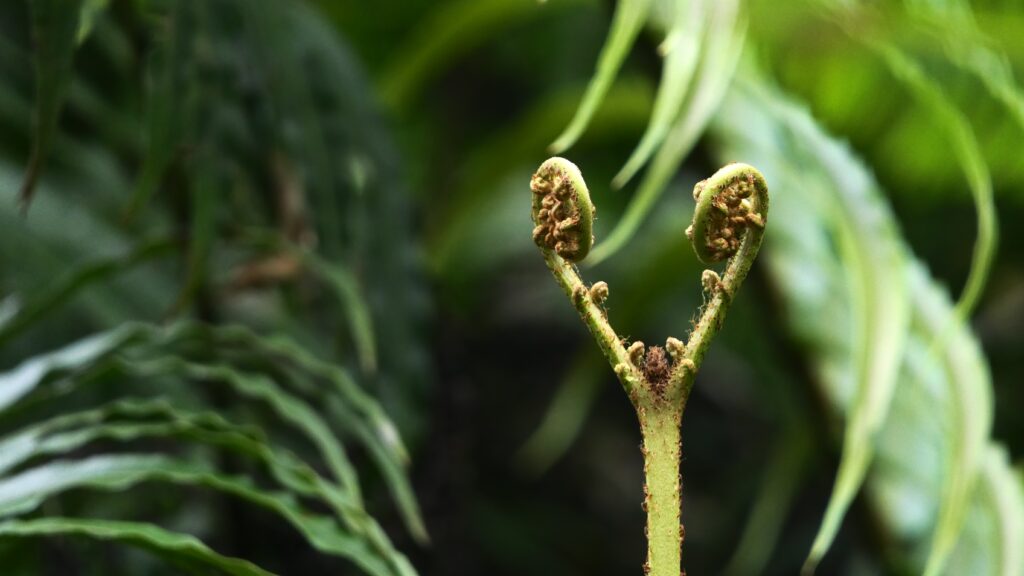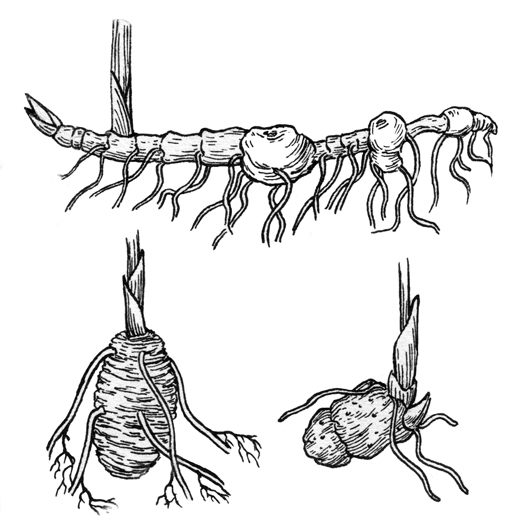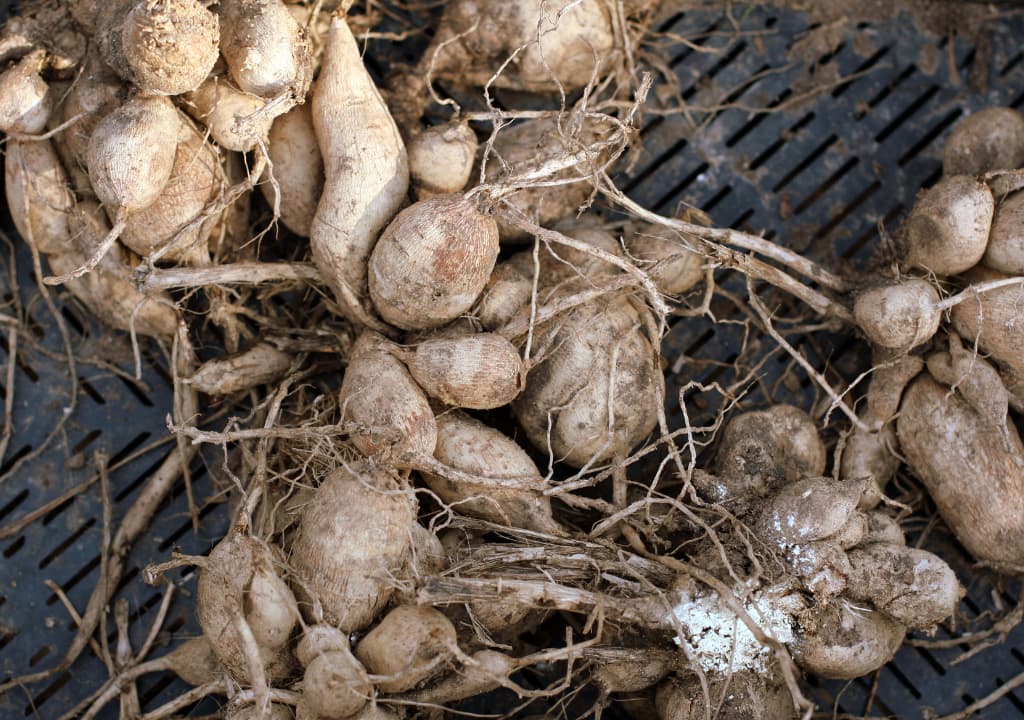
What is a rhizome and how it differs from other types of plant structures
While stolons are the stems of the plants that grow above the soil surface, rhizomes are the plant stems growing under the soil. However, there are some plant varieties, such as some species of Iris, that have rhizomes growing out above the ground. There are some other differences between rhizomes and stolons. For example, a stolon grows out of an existing plant stem and has a much wider internodal spacing.
Rhizomes differ from other types of plant structures such as bulbs, corms and tubers, which are also underground storage organs, in that they are generally not formed from modified leaves or stem, but a stem that runs underground, and they can also produce new shoots and roots.
Rhizomes, sometimes also referred to as creeping rootstalks or rootstocks, are needed to produce roots and stem shoots. That is why they come with compact internodal spacing.

One of the features that often come with rhizomes is their wild spread. A rhizomes barrier can be helpful in that case, as it helps to keep the plant within its intended borders.
Did you know that rhizomes are often used to propagate plants? You can cut rhizomes into parts, and each part is capable of growing into an individual plant. Bamboo, ginger, hops, asparagus, canna lilies, and even venus flytrap are just a few of the many plants commonly propagated in this way.

What plants grow from rhizomes?
It’s nearly impossible to include a list of every plant that can be propagated using rhizomes – there are so many of them! And many plants usually propagated from rhizomes can also be cloned by other techniques such as stem cuttings and division. Before starting any propagation project, do your research to find out the best methods for your chosen plant. If you want to try growing new plants from rhizomes, here are some plants you could propagate.
Zamioculcas zamiifolia alias Zanzibar gem is one of the most common plants that is easily grown from rhizomes. Check out the detailed guide!
There are many other plants that could be multiplied with this vegetative propagation technique. For example, the following varieties can be propagated with this form of asexual plant reproduction:
The benefits of propagating plants using rhizomes
Why propagate plants from rhizomes? There are several good reasons for that – ease of growth, cost-effectiveness, and the ability to produce multiple plants from one parent plant, to name a few.
If you already have an established plant at home, it’s always cheaper to propagate it rather than buy a new plant. But even if you don’t own the plant variety you want to grow, you don’t need to buy a mature plant. Most plant nurseries sell plant rhizomes, and they tend to be noticeably lower on the price scale than established plants. So propagating plants from rhizomes is very cost-effective.
While rhizome propagation is a bit messy, it’s a simple process that everyone can do. All you need to do is dig up your plant, cut the rhizomes, leave them dry, and plant them back into the soil. The only necessary tool is a clean pair of gardening shears or a knife.
And my favorite benefit of rhizome propagation is the ability to turn one established plant, not in two, but into several new plants. That makes it a preferred way of propagation for many home gardeners, landscapers, and farmers looking to expand their plant collection quickly.
The proper techniques for harvesting and preparing rhizomes for planting
If you want your first rhizome propagation project to have a successful result, it’s good to know the proper techniques for harvesting and preparing rhizomes. Luckily for junior gardeners, rhizome propagation is simple and pretty quick!
Only use mature and healthy parent plants for taking rhizome cuttings. Always inspect the rhizomes before cutting into them. Healthy rhizomes are plump and firm. If you can see signs of pests or disease or the rhizomes are mushy, it’s not worth using them.
Once you’ve located the healthy rhizomes you want to use, cut them in half or into parts. Ensure that each section has at least one bud and a short piece of stem attached – this is needed for a new plant to grow. A good tip to avoid rot is to dust the cut ends with fungicide.
Leave the rhizomes in a dry and cool place to dry – a few days is good enough. Once they are dry, plant them and maintain regular care.
Tips for maintaining and caring for rhizome-propagated plants
Harvesting and preparing rhizomes correctly don’t pay off if you forget to take care of them afterward. For a successful propagation project, provide the rhizomes with proper care after planting them.
The correct care of the rhizome largely depends on the plant you’re propagating. Some plant varieties require more light and warmth than others. Keep that in mind when choosing a location for your rhizomes.
Rhizomes should be planted in well-draining soil – this helps to avoid the potting mix turning soggy, which could lead to rot. Water the soil regularly but don’t overdo it. Rhizomes want a moist, not wet, environment.
If planting more than one rhizome in a container, ensure you space them out to avoid overcrowding and allow each section room for growth. Similarly, this out the grown plant when needed.
And, of course, keep an eye out for any potential issues, such as pests and diseases.
Frequently Asked Questions
The answer to this is yes and no. There are many different propagation techniques – not every method can be used for every plant. But many plant species are propagated from rhizomes! Bamboo, iris, lilies, turmeric, canna lily, Daylilies, and Hostas are just a few examples – the complete list is way longer than that!
How do you take cuttings from rhizomes?
Taking cuttings from rhizomes is pretty simple but only works for plant species that can be propagated from rhizomes, so always do your research!
- To start, gently dig up the plant from the soil and locate the rhizomes you want to take cuttings from – always choose a rhizome that looks healthy, plump, and disease-free.
- Separate the rhizomes into sections, leaving each one with at least one ¨eye¨ and a piece of stem.
- Let the rhizomes dry for a few days before planting them back into well-draining soil.
- Maintain regular care – allow them to get some sunlight and keep the soil moist, yet not wet.
- Once the rhizomes have grown into established plants, repot them.
How long do rhizomes take to sprout?
Most plants take anywhere from a week to a month to sprout. However, there are some exceptions – for example, ginger and turmeric can need as much as a couple of months to sprout, and bamboo can take even longer. The time window necessary for a rhizome to sprout largely depends on the specific plant species, the environmental conditions, and the season of being planted. Some plants don’t grow until the following season – remember to stay patient and not get discouraged too soon.
Do you soak rhizomes before planting?
While soaking rhizomes before planting isn’t always needed, it can speed up your germination process. Always do your research on the specific plant variety you’re propagating, as some plants can benefit from being soaked, and others aren’t affected by it. If you’ve decided to soak the rhizomes you’re using for your propagation project, leave them in water for several hours or overnight and plant them immediately after removing them from the water. Avoid leaving them in the water for longer than overnight, as this can cause the rhizomes to rot.
Do rhizomes multiply?
Yes, rhizomes allow plants to multiply. Many plants carry underground stems, also called rhizomes – the purpose of those stems is food storage and vegetative reproduction. Rhizomes grow horizontally and sprout roots and shoots from their nodes. The ability to produce new shoots and spread quickly allows plants with rhizomes to expand their range and colonize new areas fast.
How do you propagate perennials with rhizomes?
To propagate a perennial plant from rhizomes, ensure that the chosen plant is mature and healthy.
- Dig the plant up, revealing its rhizomes, and cut them into sections – leave at least one bud and a bit of a stem on each one.
- When replanting the rhizomes, ensure that the buds stay facing upwards.
- Use well-draining, moist soil and keep the plant in a warm and sunny spot while they grow.
Can I cut a rhizome in half?
Yes, you can! In fact, you have to if you want to propagate a plant from rhizomes. Dividing rhizomes into several parts is common practice when propagating plants with those underground stems. As long as you leave each half with one bud on it and a piece of stem attached to it, the rhizome will grow into a new plant. Pay attention to the tools you’re using to cut your rhizomes – your garden shears, knife, or scissors should always be sharp and clean. Let your rhizomes dry for a few days before planting them to avoid the rhizomes rotting and increase the chance of success.
What plants propagate rhizomes?
Many herbs and ornamentals are propagated with the help of rhizomes.
Bamboo, ginger, iris, lilies, turmeric, canna lilies, daylilies, and hostas are often cloned using rhizomes. However, those are just a few examples, and the list isn’t limited to the mentioned plant varieties. Always check the needs of a specific variety before propagating it.